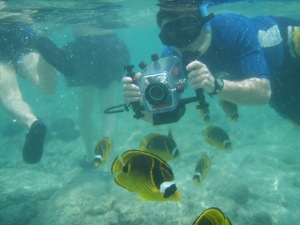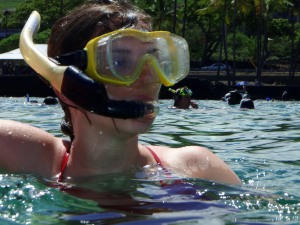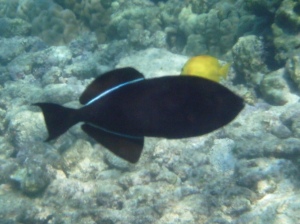
Coming to my island for a vacation? There are three things I always recommend the first-time visitor do. First, get in the air. Secondly--go to a luau. Finally, I advise people of every age to get in the water and go snorkeling. The "one-one-one, experiencing the world through the fishes' eyes" magic of swimming in those bath-warm lagoons surrounded by clouds of tropical fish is an amazing, restful and restorative pursuit-you will find your mind going back to that experience over and over through the years much more so than many of your other travel experiences.
Part I of this series discuses Snorkeling Gear; Part II of this series will discuss Snorkeling Technique and Part III will cover Snorkeling Etiquette; Part IV of the series covers Snorkeling Safety and Part V will cover Big Island Snorkel Spots.
Part II: Let's talk about technique: how are we going to do this?
Before getting into the water, where is your partner? Never snorkel alone; never get more than 20 feet from your partner. Memorize the color of your partner's mask and snorkel…this is how you will recognize him from a distance in the water.

Also before getting wet, you should make sure your mask is clean and that you have applied some form of defogger to it, either the commercially available solution (DO NOT get this stuff in your eyes!) or by simply rubbing some spit over the insides of the lenses. Pull the mask on your head, leaving it perched up on your hair as you enter the water. You should enter the water on a sandy patch of beach that does not drop off too steeply and is not in an area attacked by large waves.
Do not put your fins on before you are in the water. After wading out until the water is between knee and waist deep, face the incoming waves, sit down (this will also help you adjust to the temperature of the water--sometimes a bit of a shock but soon you get used to it) and pull your fins on. From this position, duck your head under and get your hair and face wet (to help the mask seal). Now stand up and pull the mask down, arranging hair, strap and snorkel mouthpiece to maximize the seal integrity and personal comfort. This may take some adjusting to get all the hair out from under the seal, to get the snorkel mouthpiece in the right position and get comfortable. Don't worry if there is a little fog on the mask at this point.
When the mask is sealed and you feel ready, bend at the knees, stretch arms forward and lean forward slowly until you are floating. Kick rhythmically, steadily, but at a pace you can keep up for some time. See? IT'S FUN! Oh, wait--don't forget to breath! Seriously, some people may feel a little claustrophobia at first with the mask and snorkel, and in chilly water it's natural to have short, gaspy breathing by instinct. Relax, concentrate on taking slow, even breaths. Snorkeling is relaxing, to be sure, but you have to be relaxed to snorkel. Breathe. Smoothly, rhythmically.
Many people find they breathe and move more efficiently with their hands clasped behind their backs. Use your hands in sweeping motions to turn, or back up or fend-off too-near snorkelers, then clasp them back behind you again for cruising. Again, breathe. Smoothly, rhythmically.
If at any point you feel uncomfortable, simply stop, tread water (or stand up in the shallows), and put your mask up on top of your head. Look around you. See? It's easy! But never, ever remove your mask all the way while in the water--you could drop it or it could be taken by a wave and then you'd be having significantly less fun, really quickly. If there is fog in your mask, pull your mask away from your face just a fraction of an inch and just for a moment while under water to allow just a little bit of water in. Pull your head out of the water, allow the water in the mask to rinse away the fog, then tilt the mask away from your face just a moment again to drain the water out. Practice this in a place you feel comfortable. When you get good, you can do this without even stopping--this technique also allows you to clear your mask of leakage (and all masks leak a little) while on the go.
What's that gurgling noise? Occasionally, especially if the surf is up or you are diving, water gets trapped in the snorkel. You can purge the snorkel simply by exhaling strongly through it and blowing the water out the top, or more easily by lifting your head above water, spitting out the mouth piece and allowing it to dangle in the air and drain clear. Cake.
Poke your head out of the water frequently to check that your partner is within 20 feet of you and to keep yourself oriented relative to your entry and exit places. Stay alert--it's easy to loose track of time, get carried farther than you thought by a current you didn't even notice, wander out of your comfort zone, lazily paddle away from your partner, accidentally stray into a dangerous zone. So stay focused, stay oriented, always know where you are, where your partner is.

Gosh, what's that down there on the bottom? Diving is what snorkeling is all about. Do not expect to go deeply; do not expect to stay down long; err on the side of safety, be conservative in your actions. The ocean is composed of stacked layers, frequently of surprisingly different temperatures, sometimes distressingly moving in different directions. It is entirely possible to be swimming in quiet water, dive a half dozen feet under the surface and find yourself caught by a current you didn't even know existed…don't fight it, but turn and kick to the surface immediately so you can evaluate this new wrinkle while catching your breath.
To dive efficiently, start off by floating flat, face down, on the water. Fill your lungs and empty them completely a few times to charge your blood with oxygen. One more big breath in, then let half out (a lung-full of air will make you floaty and keep you from diving very deeply); with your arms forward, pointing at your target, bend at the waist, kick once then lift your feet in the air, allowing the weight of your legs to push you under. Keep kicking as you submerge. Do not over estimate the depth you can dive or the time you can spend down. Learn your limits slowly and safely. Uncomfortable? Turn quickly and kick to the surface, breathe, rest, try it again. Water pressure on the eardrums will make your ears ache in just a few feet of water; to alleviate the pain and adjust the pressure in your head, as you dive pinch your nose, close your mouth and "blow" to pop your ears. If pain, discomfort, dizziness or other distress continues, turn and kick to the top. Stay there for the duration of your swim.
Where are all the fish? The water near shore may be murky from fresh-water springs, lots of people wading or surf action; swim out a little until the water gets crystal clear…that's better. Although you will likely see large swarms of fish swimming about all over the bay, remember they live along the rocks and coral and not over sand, so that's where the most interesting stuff is. Check out cliffs, ledges, pockets and boulders. Look closer. You can get a cheap, disposable underwater camera for less than ten bucks at WalMart--it may be the best $10 you spend on your whole trip. Get two. Don't forget to take pictures of each other, too.
Before you get tired, before you feel your back getting sunburned, before you shoot the last picture, before the wind comes up or the surf builds, it's time to get out. Don't push it, the ocean plays for keeps. Remember your plan; where's your sandy exit point? Swim toward it; keep swimming until you are in about the same depth of water where you put your fins on--it's easier to stand up from a floating position in about navel-deep water. Keep your eye on the ocean as you walk out onto the beach. Wasn't snorkeling amazing? Wait'll you see those pictures!
After getting out, trust me, you are going to want to rinse yourself off--the ocean salt is really irritating to your skin as you dry off. You also need to thoroughly rinse your gear--the salt attacks and destroys the rubber and plastic. If there are not showers or any way to rinse off where you are snorkeling, you should bring a jug of water (about one gallon per person for body, hair and gear will do it) to do this. No, no, you really, really will want to rinse off after, I promise.

Part III of this series will discuss snorkeling etiquette; Part IV will discuss snorkeling safety and art IV will discuss the best places on the Big Island to go snorkeling.
For more information on traveling to Hawaii in general, and beach activities on the Big Island in particular, visit www.tourguidehawaii.com and www.lovingthebigisland.wordpress.com. For information on the author, go here.

No comments:
Post a Comment